From a practical and commercial standpoint, the first salvos were fired in California. Solidbody guitars! More volume! No feedback! Command the bandstand!
Leo Fender was a West Coast-based genius who didn’t even know how to tune a guitar, but he captured the imagination of cowpokes, blues players and emerging rockers when he released his Telecaster solidbody electric in 1950.
Gibson had its own non-guitar-playing mastermind in Ted McCarty. What the company didn’t have was a solidbody guitar.
That was about to change.

Pictured: Gibson Les Paul Standard '60s AAA Flame Top Limited-Edition Electric Guitar Tri-Burst
McCarty and his team worked for approximately one year crafting a distinctively Gibson solidbody, convinced the most famous guitarist of the early 1950s to endorse it and unveiled the new Les Paul Model at the 1952 NAMM Show in New York City.
Since then, the Les Paul struggled for popularity, ducked controversy regarding who did what on the design front (Les Paul, anyone?), was discontinued and roared back, and ultimately became one of the iconic engines of rock and so many other musical genres. You can read all about it in our article, The History of the Gibson Les Paul.
Players currently have many options available when considering a Les Paul. The Gibson Collections include Original, Modern, Artist, Custom Shop and Murphy Lab. You can ponder the most accurate clones of vintage Les Pauls ever produced (Custom Shop and Murphy Lab); tributes to ’50, ’60s and ’70s LPs (Original Collection); contemporary and enhanced models (Modern Collection); signature models (Artist Collection) and more.The following guide will help you zero in on the Gibson Les Paul that has your name on it—figuratively speaking, of course. If you’d rather explore some outstanding Epiphone-crafted Les Paul models, click to How to Choose the Best Epiphone Les Paul.

Pictured: Gibson Les Paul Supreme AAA Quilt Top Limited-Edition in Sea Smoke
Table of Contents
Quick Gibson Les Paul Model Comparison Chart
Gibson Original Collection Les Paul Models
Gibson Modern Collection Les Paul Models
Gibson Les Paul Artist Models
Gibson Custom Shop Les Paul Models
Guitar Center Les Paul Exclusives
Guitar Center Vintage Les Paul Collection
Play the Perfect Paul

Pictured: Gibson Mary Ford Les Paul Standard Electric Guitar
Quick Gibson Les Paul Model Comparison Chart
In a hurry? Well, first—don’t be. Finding the perfect Les Paul that’s just right for you can take some time, study and actual auditioning at your local Guitar Center. Second, we do know your time is valuable, so we’ve provided a basic comparison chart for selected features. After all, why peruse tons of models, if you know you really want a weight-relieved Les Paul, or would only consider P-90 pickups or a slim neck profile?
We omitted a neck-wood column because all of these Gibson Les Paul models have mahogany necks. We also recognize that neck-shape designations can be a tad mysterious—several threads on various Gibson user forums have been dedicated to decoding them—so here’s a rapid report on the Gibson profiles in our chart:
- ’50s Vintage: A fairly chunky, rounded neck. Often fondly called a “baseball bat” neck.
- Rounded: Often considered a “traditional” Les Paul profile. Feels vintage-like for those who want to grab something substantial.
- Rounded C: Still a nice round, vintage-style shape, but slightly less stocky. Usually described as a nice compromise between a ’50s baseball bat neck and a slimmer ’60s profile.
- SlimTaper: A lean and slender profile designed for overall comfort and fast playing.
- SlimTaper Asymmetric: Starts rounded and comfy for chords, and then gets flatter as you go up the neck for unencumbered soloing.
|
Model |
Body Wood |
Fretboard |
Pickups |
Neck Shape |
Weight Relief |
Enhanced Electronics |
Price* |
|
Mahogany with maple top |
Rosewood |
Two P-90s |
’50s vintage |
No |
No |
$2,599 |
|
|
Mahogany with figured maple top |
Rosewood |
Two Burstbuckers |
’50s vintage |
No |
No |
$2,799 |
|
|
Mahogany with AA figured maple top |
Rosewood |
Two Burstbuckers |
SlimTaper |
No |
No |
$2,799 |
|
|
Mahogany with AA figured maple top |
Rosewood |
Burstbucker 61R & 61T (double classic white bobbins) |
SlimTaper |
No |
No |
$2,799 |
|
|
Mahogany |
Rosewood |
One P-90 |
’50s vintage |
No |
No |
$1,599 |
|
|
Mahogany |
Rosewood |
Dogear P-90 (bridge) |
SlimTaper |
No |
Handwired with Orange Drop capacitor |
$1,699 |
|
|
Mahogany |
Rosewood |
Two P-90s |
’50s vintage |
No |
No |
$1,799 |
|
|
Mahogany |
Rosewood |
Two P-90s |
SlimTaper |
No |
Handwired with Orange Drop capacitors |
$1,999 |
|
|
Mahogany with maple top |
Ebony |
T-Type humbuckers |
'70s |
No |
No |
$3,999 |
|
|
Mahogany with maple top |
Rosewood |
Two Mini Humbuckers |
Rounded C |
No |
No |
$2,599 |
|
|
Mahogany with maple top |
Rosewood |
Two Burstbucker Pros |
SlimTaper |
Yes |
Coil tap |
$1,599 |
|
|
Mahogany with AA maple top |
Rosewood |
Two Burstbucker Pros |
SlimTaper |
Ultra-Modern |
Coil tap |
$1,799 |
|
|
Mahogany with maple top |
Rosewood |
Two Humbuckers |
SlimTaper |
Yes |
Coil tap, phase, bypass |
$1,799 |
|
|
Mahogany with AAA figured maple top |
Ebony |
Two Humbuckers |
SlimTaper |
No |
No |
$2,999 |
|
|
Mahogany |
Rosewood |
Two Humbuckers |
SlimTaper |
No |
No |
$1,399 |
|
|
Mahogany |
Ebony |
Two Custombuckers |
Rounded Custom '50s |
No |
Handwired CTS pots, Orange Drop caps |
$9,999 |
Pricing as of January 2026*
Gibson Original Collection Les Paul Models
The Original Collection pays homage to the instruments manufactured during Les Paul’s chart-topping days in the ’50s, the era of the rock and roll upstarts in the ’60s, and the classic rock years of the 1970s. They’re not conceptualized as 100-percent accurate, vintage replicas, but include some important features of the decade at hand.
If you want to dig into the rich history of this legendary guitar, check out our article on the history and evolution of the Gibson Les Paul.
Gibson Les Paul Standard '50s P-90
Why It's Cool:
- Busting at the seams with vintage Goldtop vibes
- Filled with the classic P-90 snarl
- Retro looks meets contemporary playability
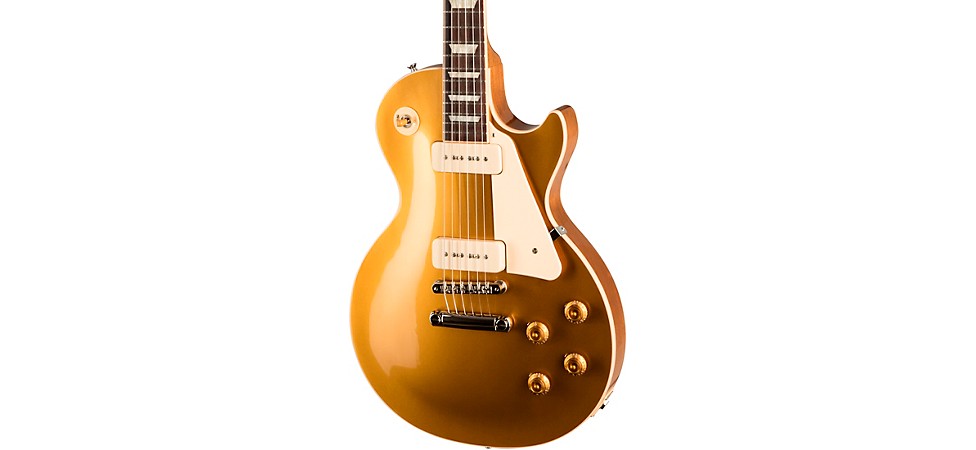
Shop Now: Gibson Les Paul Standard '50s P-90 Gold Top
The Les Paul Standard ’50s P-90 honors the Goldtop first introduced in 1952. If you’re not into evoking the spirit of Les Paul playing his Goldtop on stages and TV shows in the ’50s, you can go for a non-vintage tobacco sunburst finish. You won’t have to struggle with the original’s trapeze tailpiece, either, as the Standard ’50s P-90 has a Tune-O-Matic bridge and aluminum stopbar. Other features include a maple top on a mahogany body, mahogany neck, rosewood fretboard, 22 medium-jumbo frets and Gibson P-90 pickups loaded with Alnico V magnets.
Gibson Les Paul Standard '50s
Why It's Cool:
- You’re looking for that iconic Les Paul/humbucker roar
- A retro-infused axe with contemporary appointments for the modern player
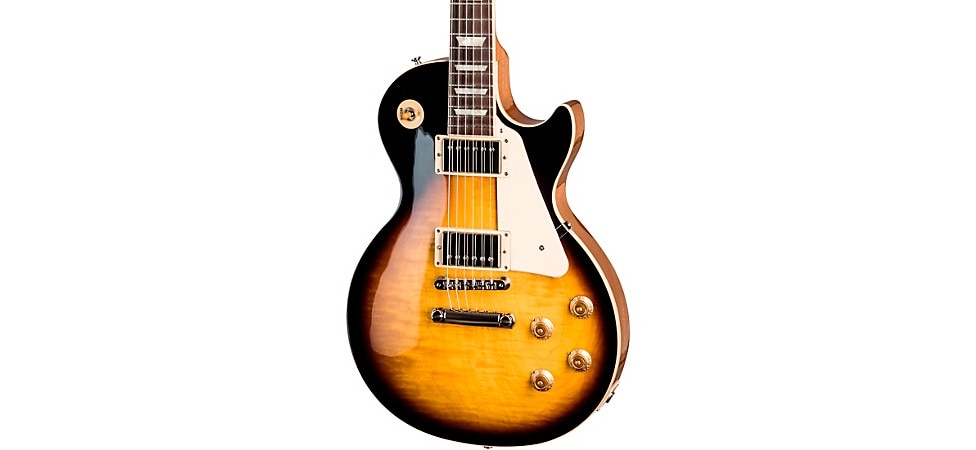
Shop Now: Gibson Les Paul Standard '50s Figured Tobacco Burst
The Les Paul Standard ’50s has the same specs as the P-90 version, except for set of Burstbucker humbuckers wound to emulate vintage PAF (Patent Applied For) tone and a figured-maple top. If you’re looking for a Les Paul that can sing like the original model used by players such as Jimmy Page, Jeff Beck, Billy Gibbons, Duane Allman and others, but feels like a streamlined and modernized instrument, this may be the one for you.
Gibson Les Paul Standard '60s
Why It's Cool:
- You can strut the look of your favorite LP Standard-wielding guitar heroes
- You can have your own version of the rich, snarky “women tone” popularized by Eric Clapton during his Cream era
- The Standard '60s boasts a wonderfully fast neck
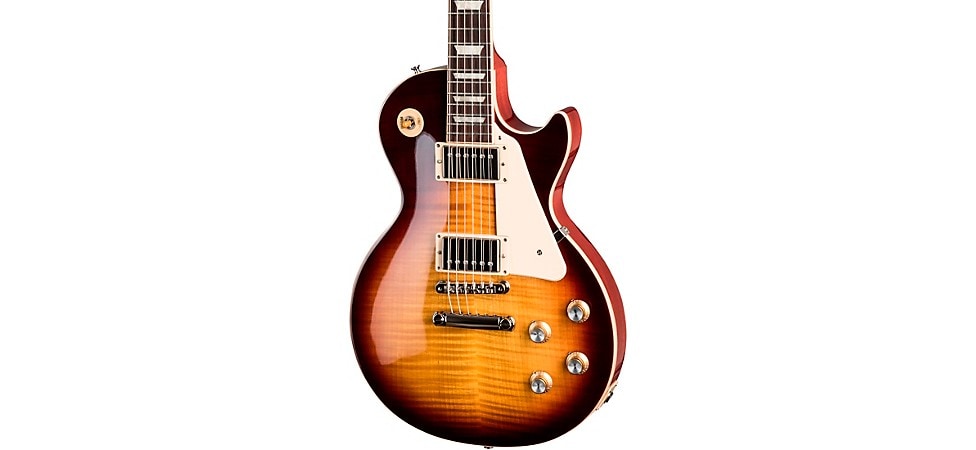
Shop Now: Gibson Les Paul Standard '60s Figured Bourbon Burst
The history of the singe-cutaway Les Paul in the 1960s is tumultuous. On one hand, you have Eric Clapton rewriting the blues rock rulebook with a 1960 Standard on Blues Breakers with Eric Clapton. On the other, the Standard was discontinued in 1960—giving way to the double-cutaway SG/Les Paul—until it was resurrected in 1968.
The Les Paul Standard ’60s, therefore, echoes the sound of players bringing the model back to prominence. This Les Paul features an AA figured maple top over a mahogany body, mahogany neck with a ’60s SlimTaper, rosewood fretboard, 22 medium-jumbo frets and Burstbucker 61 pickups. The Les Paul Standard ’60s comes in a number of stunning finishes, including a gorgeous Limited-Edition Tri-Burst. The Gibson Les Paul Standard '60s is also offered with a AAA flame top in Southern Fade, Tri-Burst, Honey Lemon Burst and Dark Cherry Sunburst.
Gibson Les Paul Standard '60s Double Trouble
Why It's Cool:
- Classic Les Paul Standard ’60s tone, now with vintage-inspired, uncovered white-coil Burstbuckers
- Solid mahogany body with an AA figured maple top for iconic Les Paul resonance and sustain
- Vintage-style nitrocellulose finish in subtly faded “Vintage” Cherry Sunburst and Tobacco Burst

Shop Now: Gibson Les Paul Standard '60s Double Trouble In Vintage Tobacco Sunburst
The Les Paul Standard ’60s Double Trouble brings a fresh twist to a fan-favorite design, blending timeless ’60s Les Paul Standard specs with a touch of vintage flair. The biggest visual change? A pair of uncovered double white Burstbucker 61 humbuckers—an aesthetic and tonal nod to the legendary “double cream” pickups of the ’70s and ’80s. These handwired pickups, loaded with Alnico 5 magnets and with Orange Drop capacitors in the tone circuit, deliver articulate highs, rich mids and punchy lows. Built with a solid mahogany body, AA figured maple top and a comfortable SlimTaper neck, this model retains the feel and resonance of a classic Les Paul Standard. Gibson is also offering a Standard '50s Double Trouble that sports a '50s vintage rounded neck profile, Burstbucker 1 and 2 pickups and gold top hat knobs.
Gibson Les Paul Junior
Why It's Cool:
- A lighter, sleeker and less “fussy” Les Paul
- Perfect for fans of ’70s-style crunch, midrange growl and gritty clean tones
- The LP Junior has a storied history filled with legendary players
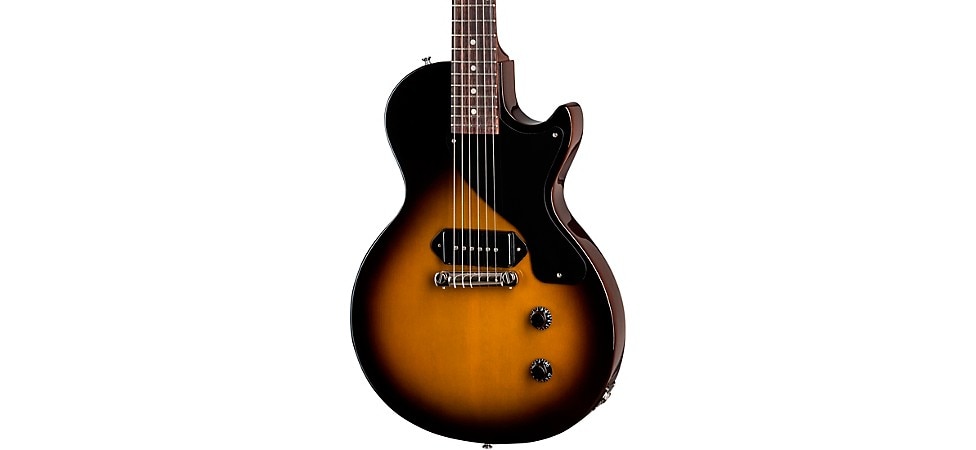
Shop Now: Gibson Les Paul Junior Vintage Tobacco
With its stark mahogany body and single P-90 pickup, the Les Paul Junior might have been intended for beginners, but that didn’t stop it from cutting a classic track—Mountain’s 1970 smash “Mississippi Queen.” Guitarist Leslie West owned a 1956 single-cutaway Junior and a newer double cutaway, but felt the single cutaway had the better sound for “Mississippi Queen.”
“It always felt like the guitar was trying to jump out of my hands,” West told Guitar Player. “I didn’t feel like I needed a two-pickup guitar, because you can get a lot of tones out of one pickup. If you’re in a room filled with gasoline, how many matches do you need?”
The Gibson Original Series Les Paul Junior features one dogear P-90; wide, ’50s-vintage mahogany neck; rosewood fretboard; 22 medium-jumbo frets and a vintage, compensated wraparound bridge.
Gibson Les Paul Junior Double Cut
Why It's Cool: This stripped-down classic proves one pickup is all you need for raw tone and endless expression.
Things to Consider:
- Single Dogear P-90 lets your picking hand control the mix of grit and chime
- Wraparound bridge anchors the string energy straight into the mahogany for extra sustain
- SlimTaper neck keeps vintage feel but plays fast and smooth
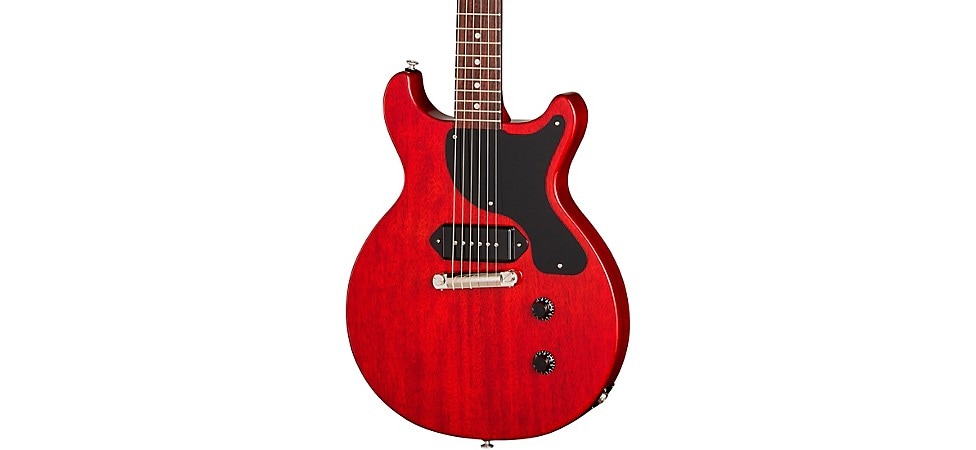
Shop Now: Gibson Les Paul Junior Double Cut in Vintage Cherry
There’s something timeless about a one-pickup Les Paul. The Junior Double Cut isn’t about options—it’s about attitude and touch. With just a Dogear P-90, volume and tone, you can go from smoky cleans to snarling crunch with your right hand alone. The double-cut body gives full fretboard access, and the slab mahogany construction keeps every note thick and alive. It’s the kind of guitar that rewards players who like to dig in and let the amp breathe.
Gibson Les Paul Special
Why It's Cool:
- The simplicity of the Junior, but with two P-90s for more tonal versatility
- A basic Les Paul, but with a bit more style than a Junior
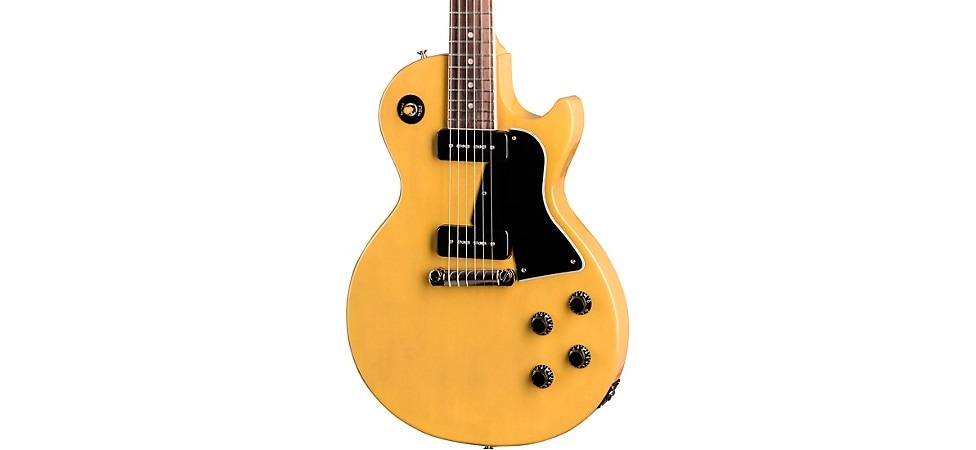
Shop Now: Gibson Les Paul Special TV Yellow
The Les Paul Special celebrates the single-cutaway style from 1955 that came with a flat, rather than carved, top. It’s a beautifully scrappy guitar with a mahogany body, mahogany neck and rosewood fretboard, 22 medium-jumbo frets and a pair of P-90s. Players such as Bob Marley and Dean DeLeo from Stone Temple Pilots cut some of their best work on a Gibson Les Paul Special.
Gibson Les Paul Special Double Cut
Why It's Cool: This vintage-style workhorse brings back dual-P-90 grit and the stripped-down charm of a ’50s Special.
Things to Consider:
- Dual P-90 pickups cover everything from blues snap to punk snarl
- Simplified wraparound bridge keeps resonance focused and setup straightforward
- Relocated pickup selector gives quick reach for live tone changes
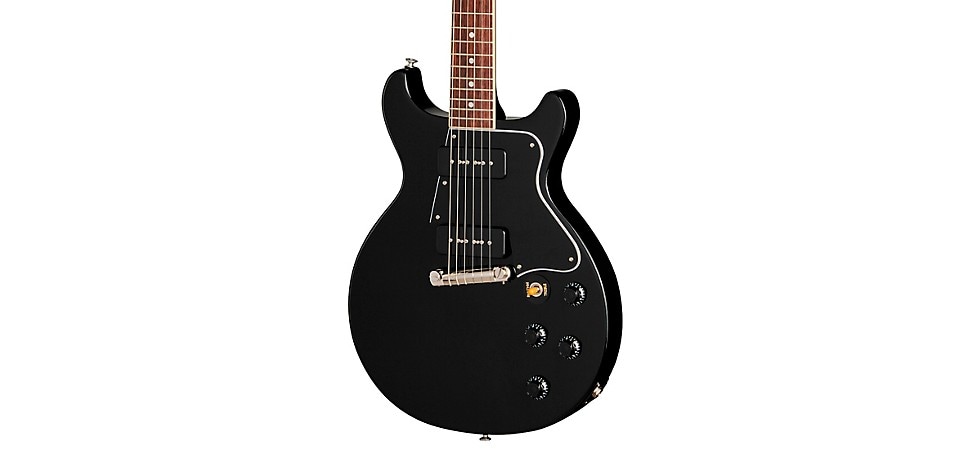
Shop Now: Gibson Les Paul Special Double Cut in Ebony
The Les Paul Special Double Cut feels like an old friend that just happens to sound amazing through any amp. Two P-90s give it that chewy, midrange-forward character that slices through a mix without overpowering it. The wraparound bridge and vintage tuners keep things light and resonant, and the double-cut shape lets your hand find every fret without thinking about it. It’s one of those guitars that feels alive in your hands—equally at home in a sweaty club or a studio tracking session.
Gibson Les Paul Custom '70s
Why It’s Cool:
- ’70s-style appointments throughout, including keystone tuner buttons and Witch Hat knobs
- Neck includes the famous volute at the headstock
- Available in Buttercream, Ebony, Tobacco Sunburst and Wine Red
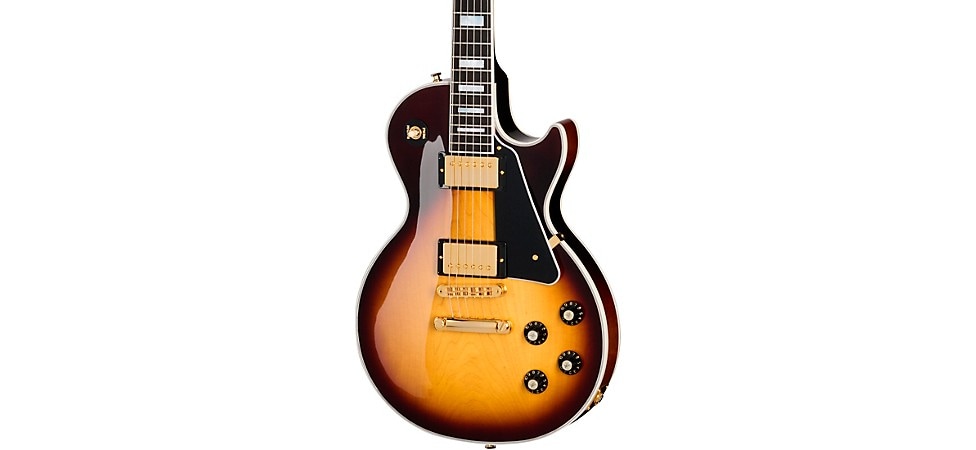
Shop Now: Gibson Les Paul Custom '70s in Tobacco Sunburst
The Les Paul Custom’s origins date back to 1953, though widespread production of the model didn’t truly take off until the 1970s, when Gibson relocated manufacturing from Kalamazoo, Michigan, to Nashville, Tennessee. These reissued Les Paul Custom ’70s models are period-accurate recreations from a celebrated era in Gibson history, offering coveted specs without the vintage markup. Plus, they’re made by Gibson USA—not the Gibson Custom Shop—so production numbers will be higher and prices a little lower.
Notably, 1970s Customs introduced a maple cap on the chunky mahogany body and a maple neck to the recipe, lending a touch of clarity and snap to the otherwise dark tonality of all-mahogany construction. Gibson Les Paul Custom ’70s models also include balanced, dynamic T-Type humbuckers (a nod to classic T-Top pickups made from 1966–1979); handwired electronics using high-quality Orange Drop capacitors; Grover Rotomatic tuners; and the fabulous dressed-up, gold-accented look of a timeless silhouette in four enviable nitrocellulose finishes.
Gibson Les Paul '70s Deluxe
Why It's Cool:
- You can tap into the look and sound of Pete Townshend’s numbered, ’70s-era Les Paul Deluxes
- Allows you to explore the unique tones produced by mini humbuckers

Shop Now: Gibson Les Paul '70s Deluxe Gold Top
The Les Paul ’70s Deluxe struts two mini humbuckers. Because the minis interact with a shorter length of the guitar string, they typically produce a dip in output, diminished low end and clear, articulate high-end shimmer. The Who’s Pete Townshend was a fan, adding Les Paul Deluxes with mini humbuckers to his live arsenal in 1973. The Les Paul ’70s Deluxe offers a comfy, rounded C-shape mahogany neck; rosewood fretboard with 22 frets and a mahogany body with maple top.
Gibson Modern Collection Les Paul Models
The Modern Collection honors Gibson’s spirit of innovation by adding contemporary updates to the Les Paul platform, such as slimmer necks, lighter bodies and other enhancements.
Gibson Les Paul Studio
Why It's Cool:
- An accessible Les Paul that doesn't sacrifice tone or playability
- Powerful pickups and a fast, comfortable neck
- A classic Les Paul design with modern features like coil taps and Ultra Modern weight relief

Shop Now: Gibson Les Paul Studio in Ebony
The Les Paul Studio is a great option for players who want the iconic tone and playability of a Les Paul at an accessible price. The mahogany body is chambered for weight relief and resonance, high-output Gibson Burstbucker Pro pickups deliver epic crunch and sustain, two push-pull pots provide coil tapping for tonal versatility and the cream-bound SlimTaper neck offers comfy playability
Gibson Les Paul Studio Figured Limited-Edition
Why It's Cool:
- AA figured maple top adds a premium look to the Les Paul Studio formula
- Burstbucker Pro pickups deliver articulate high-gain tones with coil-tapping versatility
- Ultra-Modern weight relief keeps it lightweight without sacrificing sustain

Shop Now: Gibson Les Paul Studio Figured Limited-Edition in Triburst
For players who want a high-performance Les Paul without the extra flash (or price tag), the Gibson Les Paul Studio Figured Limited-Edition hits the sweet spot. It keeps the no-nonsense attitude of the Studio series but upgrades the look with an AA figured maple top. Equipped with Burstbucker Pro pickups, this model delivers everything from thick, vintage-voiced PAF tones to more cutting sounds, thanks to coil-tapping functionality. The SlimTaper neck ensures fast playability, while Ultra-Modern weight relief keeps it comfortable for long sessions.
Gibson Les Paul Modern Studio
Why It's Cool:
- A more high-output Les Paul
- Give you the option of switching between humbucker and single-coil sounds
- The Modern Studio has an unbelievably fast neck

Shop Now: Gibson Les Paul Modern Studio in Wine Red Satin
The Les Paul Modern Studio supercharges the straightforward design of the original 1983 Studio. The mahogany body is chambered for weight relief and resonance, high-output Gibson 490R and 498T humbuckers deliver epic crunch and sustain, while push-pull pots provide coil tapping, phase reversal and pure bypass. A SlimTaper neck offers comfy playability.
Gibson Les Paul Modern Figured
Why It's Cool:
- A stunning, eye-catching finish and a weight-relieved body
- Hot pickups that are also capable of expressing sensitive dynamics
- Gives you the option of switching between humbucker and single-coil sounds
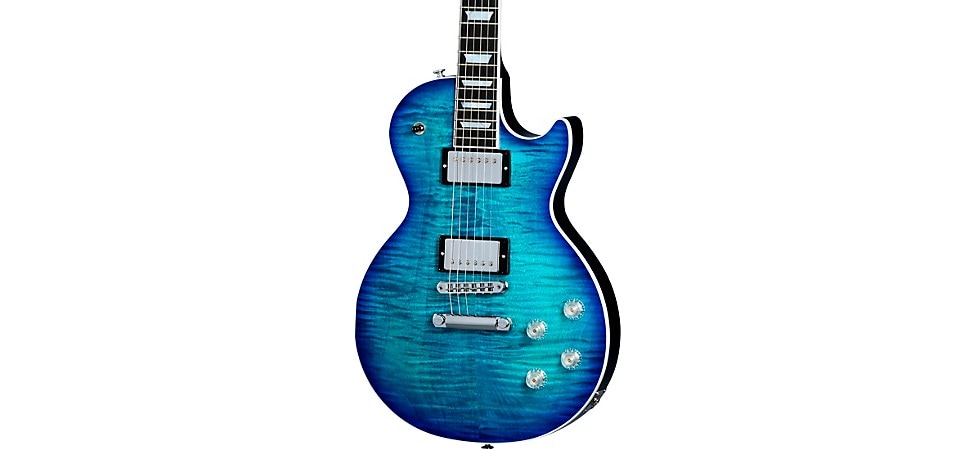
Shop Now: Gibson Les Paul Modern Figured Cobalt Burst
Few guitars look as gorgeously upscale as a Les Paul with an AAA-grade, figured maple top. The Gibson Les Paul Modern Figured provides all of that flash, along with comfy ergonomic enhancements, such as an Ultra-Modern weight relief mahogany body, a SlimTaper neck profile and a Modern Contoured Heel (for burning up to those high frets). The Les Paul Modern Figured can sound as dazzling as it looks, via Burstbucker Pro pickups that can be switched between humbucker and single-coil sounds.
Gibson Les Paul Modern Lite
Why It's Cool:
- A visual stunner at a budget-friendly price
- Hot pickups that are also capable of expressing sensitive dynamics
- A noticeably thinner body and faster neck
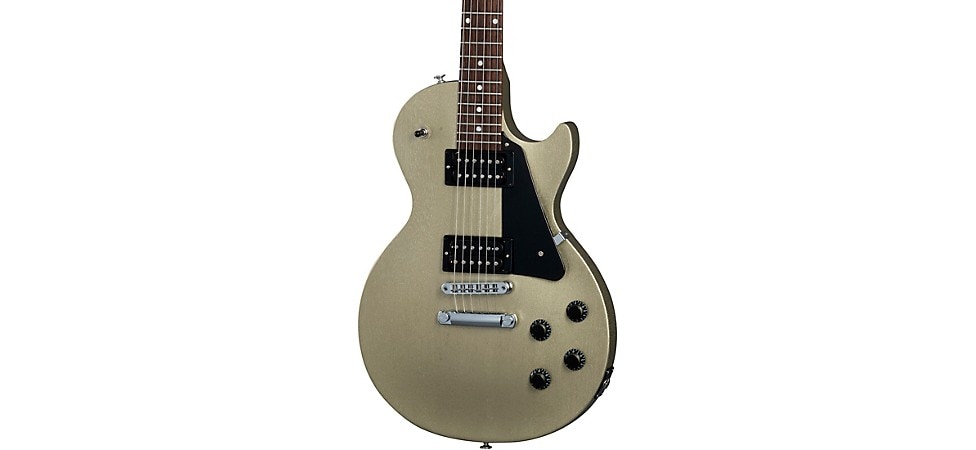
Shop Now: Gibson Les Paul Modern Lite Gold Mist Satin
Offering a selection of stunning finishes with super cool matching headstocks, the Gibson Les Paul Modern Lite ups the glamor factor without introducing a luxury price tag. True to its name, the Les Modern Lite offers a slim, lightweight mahogany body with a rear belly curve, as well as a comfy SlimTaper mahogany neck. However, Gibson did not lighten up on the Modern Lite’s power, arming it with open-coil 490R and 498T humbuckers that kick out ample snarl and shimmer.
Gibson Les Paul Custom Bats in Flight
Why It's Cool: This darkly elegant Custom Shop creation combines artistry, luxury and unmistakable Les Paul power.
Things to Consider:
- Abalone “Bats in Flight” inlays and binding make this one of Gibson’s most visually striking guitars
- Dual Custombuckers deliver rich, articulate tone with vintage-style warmth
- Premium tonewoods and no-weight-relief body maximize resonance and sustain
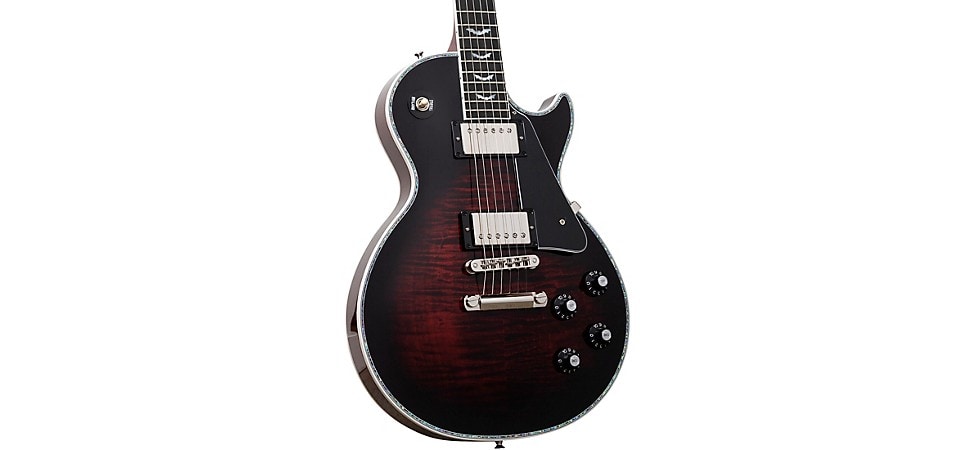
Shop Now: Gibson Les Paul Custom Bats in Flight in Dark Red Burst
The “Bats in Flight” Custom is the kind of guitar that blurs the line between instrument and art. Its quilted maple top, ebony board and abalone binding shimmer under stage lights, but the tone is pure Les Paul Custom—full, dynamic and endlessly expressive. The Custombuckers have all the bite and bloom you’d want from a top-shelf Gibson, with a dark visual aesthetic adding just the right dose of gothy drama.
Gibson Les Paul Artist Models
|
Model |
Body Wood |
Fretboard |
Pickups |
Neck Shape |
Weight Relief |
Enhanced Electronics |
Price* |
|
Mahogany with maple top |
Rosewood |
Dual soapbar P-90s |
SlimTaper |
No |
Handwires, Orange Drop caps |
$2,999 |
|
|
Mahogany with maple top |
Rosewood |
Hum-free P-90 DC soapbar |
50s Vintage |
No |
Yes (+15dB clean boost via mini toggle) |
$2,799 |
|
|
One-piece mahogany |
Ebony |
Three Alnico III Custombuckers |
Medium C |
No |
No |
$19,999 |
|
|
Mahogany with maple top |
Indian rosewood |
Burstbucker 2, Burstbucker 3 |
SlimTaper |
No |
No |
$2,999 |
|
|
Mahogany with 3-piece maple top |
Indian rosewood |
Two Custom Burstbuckers |
’50s vintage |
No |
No |
$3,199 |
|
|
Mahogany with solid mahogany top |
Ebony |
Three Custombuckers |
Artist profile |
Yes |
No |
$6,999 |
|
|
Mahogany with AAA figured maple top |
Indian rosewood |
Two Greenybuckers |
’50s vintage |
No |
No |
$2,999 |
|
|
Mahogany with maple top |
Ebony |
Burstbucker 1, DC High-Gain humbucker |
Rounded |
No |
No |
$2,999 |
Pricing as of January 2026*
Gibson Noel Gallagher Les Paul Standard
Why It's Cool: A faithful recreation of Noel Gallagher’s Les Paul, built to his exact touring specs for the “Live ’25” reunion.
Things to Consider:
- Non-weight-relieved mahogany body and bound maple top deliver vintage heft and sustain
- Dual chrome-covered P-90 Soapbars provide Gallagher’s signature punch and clarity
- SlimTaper neck with bound rosewood fingerboard offers fast feel and classic comfort
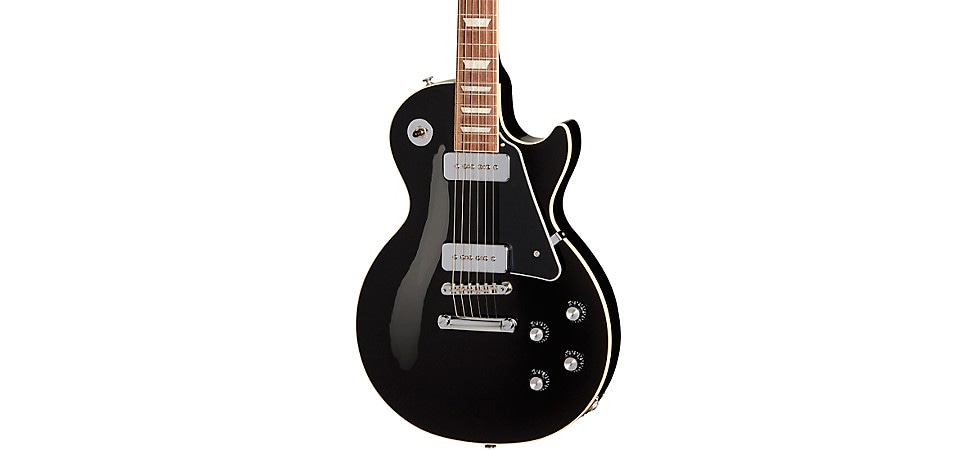
Shop Now: Gibson Noel Gallagher Les Paul Standard
The Gibson Noel Gallagher Les Paul Standard was created by Gibson, in partnership with Noel Gallagher, to celebrate Oasis' 2025 reunion tour. Plugging in, the P-90s immediately serve up that gritty roar and crisp articulation that defined Oasis’ wall-of-sound guitar work. The full mahogany body has the substance players crave for sustain and resonance, while the bound rosewood board under your hands feels broken in from the first chord. Whether you’re chasing “Champagne Supernova” tones or just want a Les Paul that blends heritage and character with the punch and growl of classic P-90s, this signature guitar can be your ticket to Britpop nirvana.
Gibson Warren Haynes Les Paul Standard
Why It's Cool:
- Custom-voiced P-90 DC pickups for hum-free performance with all the character of classic P-90s
- +15dB clean boost via a discreet mini toggle switch for instant solo power
- Comfortable ’50s Vintage neck profile for a substantial feel

Shop Now: Gibson Warren Haynes Les Paul Standard In '60s Cherry
Built to match Warren Haynes’ dynamic playing style, the Warren Haynes Les Paul Standard is a modern workhorse with a vintage soul. From The Allman Brothers Band to The Warren Haynes Band and Gov’t Mule, Haynes has built a legacy on his expressive touch and signature tone—and this guitar takes that to heart. The soul of this model is a pair of P-90 DC Soapbar pickups, delivering all the punch, warmth and clarity of traditional P-90s without the hum. A built-in +15dB clean boost, activated by a mini toggle, lets you push solos forward without needing a pedal. The mahogany body and maple top provide the sustain and resonance Les Pauls are known for, while the ’50s Vintage neck profile offers a substantial, yet comfortable grip. Finished in a striking ’60s Cherry inspired by Haynes’ beloved ’61 ES-335, this signature Les Paul bridges past and present, offering vintage aesthetics with modern versatility.
Gibson Custom Eric Clapton 1958 Les Paul Custom
Why It’s Cool:
- Recreation of Clapton’s 1958 Les Paul Custom
- Three unpotted Custombuckers capture true vintage tone
- Limited to 150 handcrafted pieces

Shop Now: Gibson Custom Eric Clapton 1958 Les Paul Custom
The Gibson Custom Eric Clapton 1958 Les Paul Custom is a replica of the guitar he purchased on Cream’s first American tour—a three-pickup “tuxedo” model, serial # 8 6320. Clapton had the guitar in the studio during 1967’s Disraeli Gears sessions, gigged it on shows with Delaney & Bonnie and the Plastic Ono Band, and kept it in his collection until gifting the instrument to Albert Lee in 1979. Gibson’s Custom Shop and Murphy Lab luthiers have ensured the replica is as accurate as possible to the legendary original. The Gibson Custom Eric Clapton 1958 Les Paul Custom comes with a Duck Brothers-inspired case, certificate of authenticity, premium leather guitar strap and a second pickguard signed by Clapton and Albert Lee.
Gibson Mary Ford Les Paul Standard
Why It’s Cool:
- Based on a one-off artist request
- Classic Goldtop vibe with unique floral flair
- Back is finished in Vintage Cherry

Shop Now: Gibson Mary Ford Les Paul Standard
Legendary vocalist, guitarist and actress Mary Ford receives a signature Les Paul Standard based on a model she requested from Gibson in 1958. Ford was one of the top-selling artists of the ’50s, seamlessly blending country, jazz and pop in her guitar playing, and delighting listeners with her smooth, soulful voice and complex harmonies. Alongside her husband—Les Paul himself—the couple sold over six million records in 1951 alone and recorded 16 top 10 hits in a brief span from 1950–1954.
The Gibson Mary Ford Les Paul Standard is based on the one-of-a-kind Goldtop she commissioned from the factory, prominently featuring an ES-295-style floral armrest and pickguard. These visual accents immediately distinguish this artist model from other Goldtops. In addition, the back of the mahogany body is finished in Vintage Cherry—a rarely seen aesthetic complement to the iconic gold finish. The stunning Gibson Mary Ford model also incorporates a comfortable SlimTaper neck, as well as versatile Burstbucker 2 (neck) and Burstbucker 3 (bridge) pickups for timeless, vintage-inspired sound.
Gibson Slash "Jessica" Les Paul Standard
Why It’s Cool:
- Inspired by Slash’s go-to LP Standard since 1988
- Subtle “racing stripe” pattern created by seams on 3-piece maple top
- Case candy includes Slash pick set, leather strap and blank truss rod cover
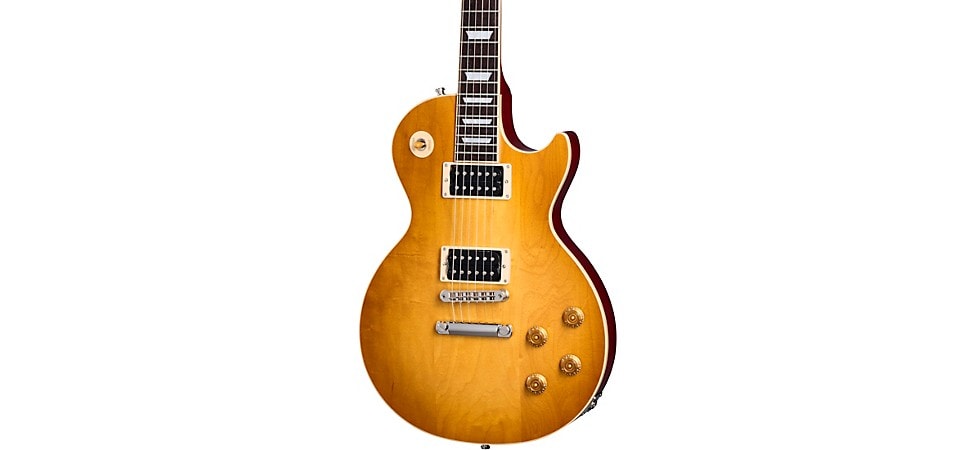
Shop Now: Gibson Slash "Jessica" Les Paul Standard
Gibson’s Slash “Jessica” Les Paul Standard pays tribute to the rock god’s main stage guitar for Guns N’ Roses all the way through Velvet Revolver. During the late ’80s, Gibson sent Slash two guitars to replace the ’59 Les Paul Standard replicas he’d chosen to retire. One was a factory second that would become his primary axe and part of his signature image into the ’90s and beyond. In true rock star fashion, Slash drunkenly dubbed the instrument “Jessica”—a name which has stuck since.
Jessica features a pair of snarling Custom Burstbuckers with an appetite for sonic destruction, serving the sizzling, sustaining, saturated tones the hard-rocking guitarist is known for. The warm, amber Honey Burst finish captures the beauty of his classic guitar, albeit without the road-worn, cigarette-burned patina. It’s fitted with a vintage-style ’50s neck—not quite the baseball bat he’s known to enjoy, but it has a comfortably hand-filling, medium-size shape many players find accessible. The Gibson Slash “Jessica” Les Paul Standard is nothing short of a rock ’n’ roll mojo machine.
Gibson Custom Peter Frampton "Phenix" Les Paul Custom
Why It’s Cool:
- Vintage Original Spec (VOS) recreation of a special 1954 Les Paul Custom
- As seen on the cover of 1976’s Frampton Comes Alive!
- Three humbuckers deliver lots of tonal versatility

Shop Now: Gibson Custom Peter Frampton Phenix Les Paul Custom
Many guitars tell a story, but few are able to recount such interesting lore as the Gibson Custom Peter Frampton “Phenix” Les Paul Custom. This meticulous recreation of Frampton’s famous 1954 Les Paul Custom is an homage to a guitar that has truly risen from the ashes. Once thought lost in a tragic plane crash in 1980, the invincible instrument somehow survived the accident and was returned to Frampton 31 years later. From that, its nickname “Phenix” was earned.
This artist model notably features three uncovered Custombuckers. One pair of volume and tone knobs is assigned to both the bridge and neck, and the other pair controls the middle pickup. It’s possible to coax an impressive variety of sounds from this Les Paul Custom and its HHH layout. The weight-relieved mahogany body boasts a gorgeous, broken-in VOS ebony finish, while VOS gold hardware appears naturally and tastefully aged. Frampton’s signature adorns the truss rod cover and 12th fret inlay as a finishing touch.
Gibson Kirk Hammett "Greeny" Les Paul Standard
Why It’s Cool:
- Modeled after one of the most well-known 1959 Les Paul Standard guitars in history
- Reverse polarity neck pickup offers distinctive sound in middle position
- Mismatched amber and gold top hat knobs are true to the original

Shop Now: Gibson Kirk Hammett "Greeny" Les Paul Standard in Greeny Burst
The Gibson Kirk Hammett “Greeny” Les Paul Standard is another example of a historically significant instrument that has been fabulously immortalized as a production model for players everywhere to experience. Greeny’s famed journey began with Fleetwood Mac founder Peter Green in the mid ’60s, who would sell the instrument to Thin Lizzy’s Gary Moore in the early ’70s. Moore cherished the guitar for over 30 years before letting it go in 2006, and it subsequently landed in the hands of its current owner—Metallica’s Kirk Hammett.
Greeny is most noted for its one-of-a-kind, out-of-phase tone. To Green’s unwitting advantage, the neck pickup in his Les Paul Standard was wound in reverse polarity from the factory. Green also accidentally reinstalled the neck pickup backwards after some DIY tech work, with its pole pieces facing the bridge. These quirks gave the guitar a totally unique character with the pickup selector in the middle position. Its distinct voice is charmingly reproduced in the Kirk Hammett “Greeny” model.
Gibson Adam Jones Les Paul Standard
Why It’s Cool:
- Attributes taken from Jones’ 1979 Les Paul Custom
- Antique Silverburst finish has a vibey, vintage look out of the box
- Ebony fretboard not often seen on a Les Paul Standard

Shop Now: Gibson Adam Jones Les Paul Standard in Silver Burst
Directly inspired by one of his favorite guitars of all time, the Gibson Adam Jones Les Paul Standard brings late ’70s Silverburst magic to the modern rock or metal player. A proper vintage Les Paul Custom in Silverburst can be hard to come by, due to the fact these increasingly rare guitars were only produced from 1978–1982. The Adam Jones LP Standard provides the feel, sound and look of his beloved 1979, sparing the more decadent aesthetic flourishes of the Les Paul Custom in favor of a streamlined silhouette. Keeping it authentic, Antique Silverburst bears the greenish, bronzish coloration of an aged nitrocellulose finish, as if you’ve cracked the case on an old-school model.
With a mahogany body and neck, maple cap and ebony fretboard, this guitar delivers the growly, throaty tones associated with Jones’ iconic riffage in Tool. The uncovered DC High-Gain bridge humbucker is aggressive and articulate, while a covered Burstbucker 1 in the neck position provides smooth, thick sounds when called for. Effortless playability is assured thanks to a comfy, rounded ’70s neck profile, complete with a period-correct headstock volute.
Gibson Custom Shop Les Paul Models

Pictured: Gibson Custom 1956 Les Paul Goldtop Reissue VOS Electric Guitar Double Gold
Gibson Custom Shop Les Pauls
Why It's Cool:
- You can get the closest Les Paul possible to a true vintage model, but don’t need to pay collector’s prices or deal with the maintenance of a decade’s old instrument
- You'll have the comfort of knowing your Les Paul was crafted by a master builder
- Simply put....they're some of the best Les Pauls that you can buy
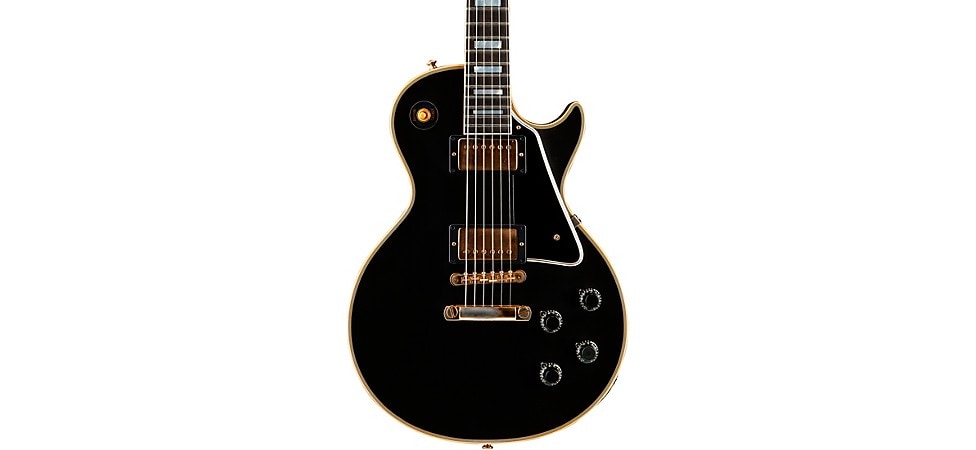
Shop Now: Gibson Custom 1957 Les Paul Custom Reissue VOS
Gibson's Custom Shop represents the pinnacle of guitar building. Manufactured in the Nashville factory, these instruments are made by master builders with an exacting level of precision. So, if you’re desperate for a 1958 Les Paul Standard, but can’t fathom spending the price of a yacht for your dream guitar, the Gibson Custom Shop can produce an accurate reissue for far less than a used Hatteras 80 Cockpit Power Yacht.
For example, the Custom Shop's 1957 Les Paul Custom Reissue Vintage Original Spec is a brilliantly detailed and meticulously crafted replica of a "mythical beast"—a Les Paul bought brand new in 1957, never played, stored away in a garage for decades and gleaming in its case and ready to play when you discovered it yesterday. It's a stunning achievement of historic—and era accurate—mojo made by artisans who seemingly know how to time travel.
Murphy Lab Les Pauls
Why It's Cool:
- You can have all of the quality and precision the Custom Shop can provide, and also have a guitar that looks like it has been played and loved for many years
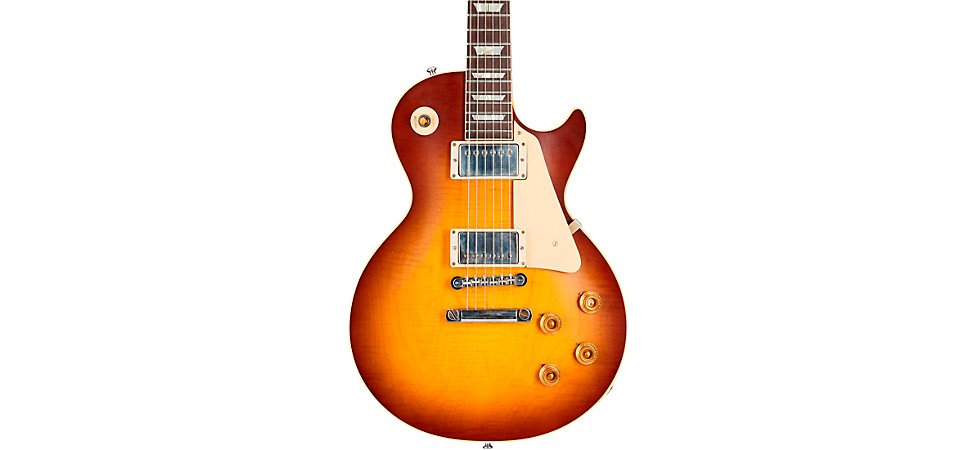
Shop Now: Gibson Custom Murphy Lab 1959 Les Paul Standard Reissue Light-Aged Cherry Teaburst
Operating as an independent division within the Gibson Custom Shop, the Murphy Lab team applies Ultra Light to Ultra Heavy aging to new Custom Shop Les Pauls and other models. Tom Murphy has spent the last two decades mastering the art and science of aging guitars. As a Gibson Master Artisan, he has cloned guitars for Slash, Eric Clapton, Jimmy Page, Gary Rossington and others.
When you want the features, sound and playability of a new Custom Shop 1959 Les Paul reissue, but with the look of a guitar that survived more than 60 years of touring clubs, bars, theaters and recording studios, the Murphy Lab delivers ultimate vintage vibe.
Guitar Center Les Paul Exclusives
Gibson Les Paul Traditional Pro V
Why It's Cool:
- A stunning guitar that can rage on stage
- Hot pickups that are also capable of expressing sensitive dynamics
- Flexible sonic options—humbucker, single-coil, phasing and treble adjustment
- A Les Paul with a compound radius fingerboard
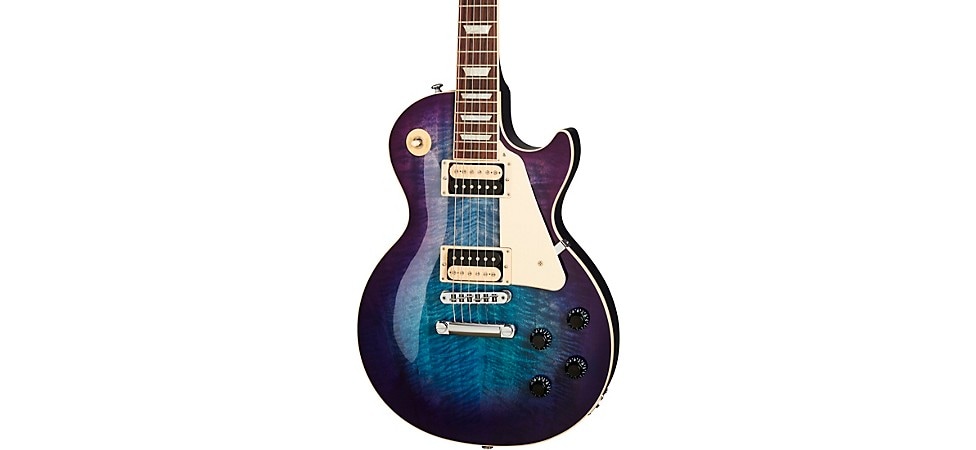
Shop Now: Gibson Les Paul Traditional Pro V in Blueberry Burst
Fully spec’d by Guitar Center, the Gibson Les Paul Traditional Pro V has an asymmetrical-profile mahogany neck for more ergonomic fretting, and a compound radius rosewood fretboard for easy chording on the lower frets and faster playing at higher registers. The Trad Pro V also offers custom-wound TradBucker pickups with Alnico V magnets. But wait, there’s more. The electronics increase tonal options with push-pot pots for coil splitting and phase, as well as a treble control in single-coil mode.
Gibson Les Paul Traditional Pro V AAA Flame Top
Why It's Cool:
- Beautiful AAA Flame Top that will stand out on any stage
- One of the most sonically versatile Les Pauls on the market today—humbucker, single coil, phasing and treble adjustment
- Internal DIP switching that allows you to create customized voicings

Shop Now: Gibson Les Paul Traditional Pro V AAA Flame Top in Ocean Water Perimeter
Designed by Guitar Center in collaboration with Gibson, the Gibson Les Paul Traditional Pro V has an asymmetrical-profile mahogany neck for more ergonomic fretting, a compound radius rosewood fingerboard for easy chording on the lower frets and faster playing at higher registers, and a variety of exclusive finishes you'll only find here. The Trad Pro V also offers custom-wound TradBucker pickups with Alnico V magnets. But wait, there’s more. The electronics increase tonal options with push-pull pots for coil splitting and phase, a treble control in single-coil mode, plus an internal DIP switch that can create personalized voicings to make the guitar truly your own.
Guitar Center Vintage Les Paul Collection
Guitar Center has an ever-changing inventory of the finest vintage Les Pauls on the planet. Collectors and players such as Joe Bonamassa keep their eyes on the prizes by hunting for Les Pauls from the model’s golden era (1952–1960)—as well as the initial reissue of the Goldtop in 1968 and the introduction of the Deluxe with mini humbuckers in 1969—and so can you. We sat down with GC's director of used and vintage Jack Hetherington to get an inside look at the process of assessing and purchasing a vintage Les Paul. For more information, check out How to Buy a Vintage Les Paul.
Why It's Cool:
- The real deal
- Instruments that are meant to be played and loved as well as those museum-quality collector's pieces
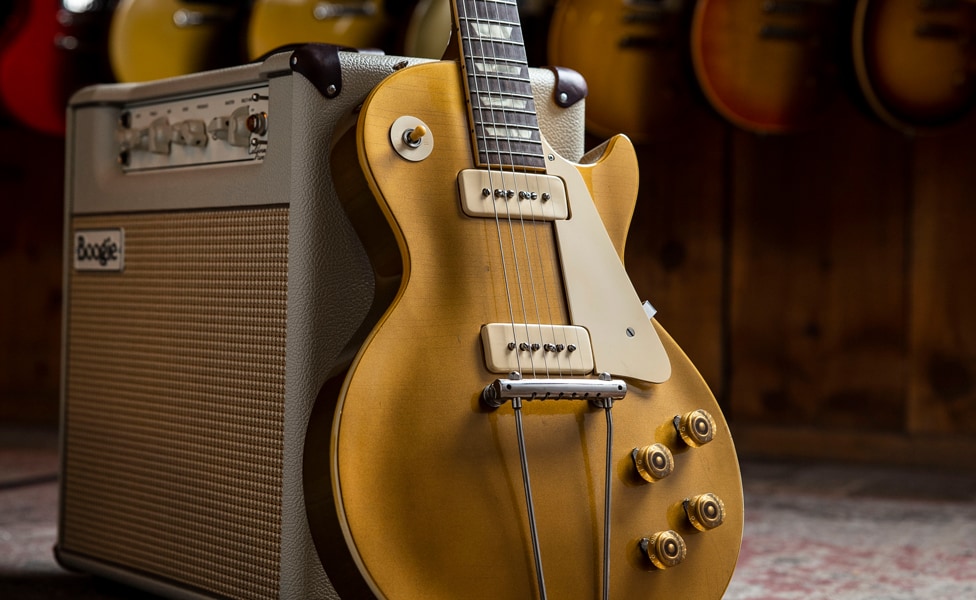
Pictured: 1953 Gibson Les Paul with Trapeze Tailpiece
Play the Perfect Paul
As this guide demonstrates, whether you’re after vintage tone and playability, want to explore more contemporary sounds with enhanced ergonomics, or are looking to create textures all your own, there is a Les Paul model that can get the job done for you. Be sure to visit your local Guitar Center to audition various models, or talk about your wishes and requirements with one of our expert Gear Advisers at 866-498-7882.
“I never stop being amazed by all the different ways of playing the guitar and making it deliver a message,” said Les Paul himself about the wide and diverse creative opportunities possible with the right instrument—in this case, a Les Paul—in your hands. Enjoy your search.
.jpeg)






